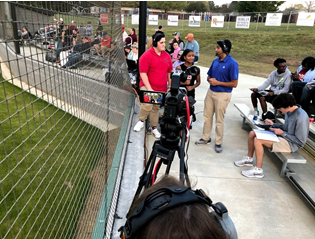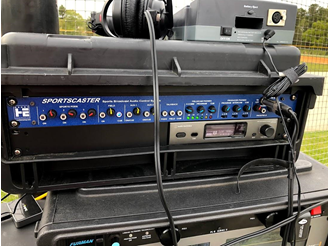The Missing Link for Great Sports Coverage
I don’t know that I will ever be able to truly “cut the cord” at my house.
I like the idea of it. I don’t watch 90% of the channels I pay for but the ones that I pay for are the ones that cost the most. I primarily watch local stations (available free over the air) and the cadre of sports channels that come from my provider.
It may come as a surprise to you that I like watching sports. I am not the guy who can tell you stats, records, winners or losers but I can typically tell you how many camera positions are being used, what types of lenses, as well as the name of the producer or the production company. I am that kind of nerd.
Over the last several years, I have tried to really push my broadcasts to be “linear” quality broadcasts. For those that aren’t aware, linear is the term that most in the industry use for broadcasts that go to TV. In the college sports world, there is a marked difference between the expectations of linear broadcast and broadcast to be streamed. While I never expect to get to the quality of ESPN, Fox, NBC, I push the limits of what can be expected at the high school and college level.
I have experimented with a ton of cameras and to be honest unless you can afford to make a huge jump to $50k+ lenses, there is no difference in shot quality. There is a difference in the number and location of your camera positions as well as the experience and skill of the operators. But most of us are using cameras in the same range... consumer to prosumer. All of that to say that cameras are not where the big difference in the final product can be found at our level.
Audio is the key to separating ourselves from the pack when it comes to broadcasting sports at the high school level. I will be frank and blunt in that I hate audio during live broadcasts. If I am going to have a problem, it is going to be with audio 90% of the time. I have long felt like getting the right tools to do it right has been out of our price range as teachers. That may no longer be the case…
Two years ago, the folks at Henry Engineering asked me to check out a potential new product that would revolutionize audio for the smaller broadcast productions. They told me it was an audio mixer with comms built in but it was so much more than that! I was extremely excited about the concept of the product because, for the last several years, I had Frankensteined an audio system together in order to have a good audio mix but to be able to talk to the talent on a back channel. My system sucked! It required two boards and a fist full of cables. It was too complex for my students to understand so I had to set it up each broadcast…
Last August, I received the Henry Engineering Sportscaster and was blown away. It was so much more than a mixer with comms built in. It was the first step to being able to have a great audio mix and be able to communicate with my talent and most importantly the next step to get toward that linear quality broadcast that I desire so much.
The Sportscaster has allowed me to not only get better audio via the simple application but allows me to coach my students while they are in the moment. Instead of having to do tape sessions a day or so after the excitement of the broadcast has worn off, I can help guide them live. It allows me to have a real producer when we do a show. The producer can help the talent through the broadcast by giving stats, forecasting upcoming storylines, etc.
What separates the amateur broadcasts from the pros is audio. Getting talent audio is really quite simple because that is what everyone thinks of first. While talent audio is probably the most important, what happens when there is a break in the action and you turn your talent microphones off? Does your broadcast go silent? If so, you should really think about adding some sort of ambient microphone to pick up crowd noise or just natural sound.
When the action is happening how do you get audio to help spice up your video? The thing that I have worked on to improve our audio for our shows is finding more ways to get audio from the action into the broadcast. That’s one of the toughest things to do in my opinion because that typically means wireless systems which typically means more trouble. When the networks roll out to broadcast, they bring a ton of microphones. For baseball, they bury them into the field, mic players, put ambient microphones throughout the park and more. That sounds like a major headache for productions at our level. I recently connected with Klover products and got my hands on a Sound Shark. The Sound Shark is a parabolic microphone that brings the action from the field or the court straight into the ears of the viewer. My students call the parabolic microphone “that thing they have on the sidelines at football games.” Which is probably the best way to get you familiar with what it is. What it does is slightly more complex… A parabolic microphone is simply a device that uses a parabolic dish to aim incoming soundwaves toward a microphone. What is a parabola? Ask a math teacher…
Last month during the MLB home run derby, my wife asked why ESPN was adding those “swooshes” when Vladimir Guerrero Jr. swung the bat. I assured her that they didn’t add them but that he was mic’ed and you could hear him exhale. I showed her a video from one of our high school baseball games to show how it helps make the broadcast better. While MLB had wireless microphones on the players and buried around the home plate area, I used a parabolic microphone. I was able to get audio that felt like it was 5 to 10 feet away from the players while I was sometimes over 150 feet away.
Pairing the Sportscaster with the Sound Shark to get great in-game audio with a sprinkle of ambient and a handful of great talent audio will make our broadcasts stand out to the viewer… or more importantly, it won’t because it is what they expect when they watch sports!
Meet the Author, Tom White
Tom White is the digital media instructor at Morgan County High School in Madison, GA. Currently teaching TV production and animation pathways, Tom's programs have received state and national honors including the 2016 NFHS Network School Broadcast Program Of The Year.
Prior to teaching, Tom was a marketing, promotions, and online content director for a major radio corporation in Atlanta. Tom studied exercise science at High Point University prior to his radio career. Despite his winding career path, his mother still thinks he is special.




